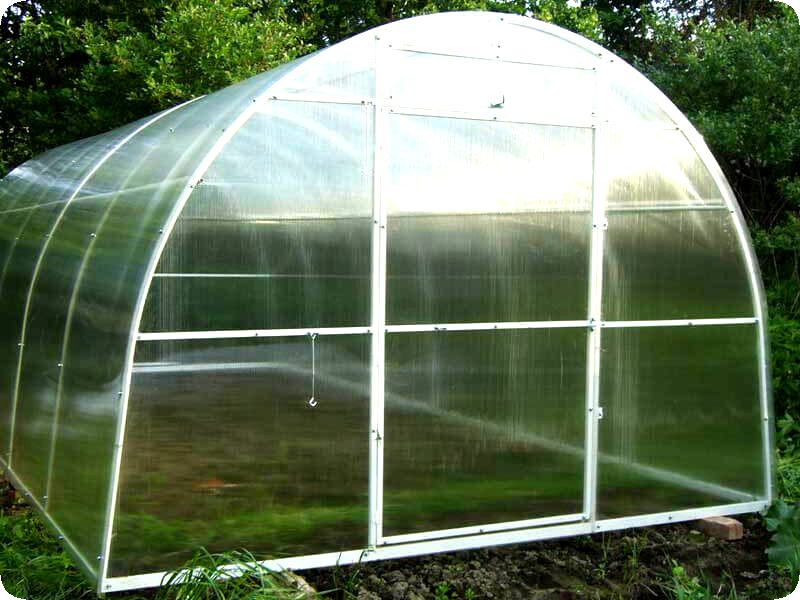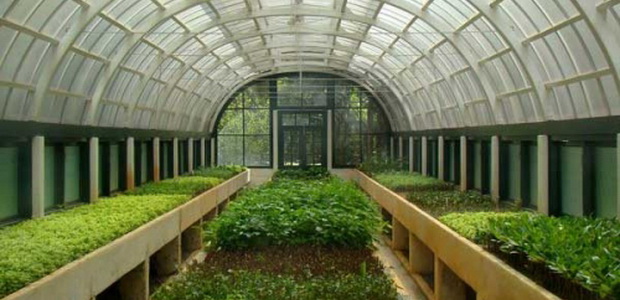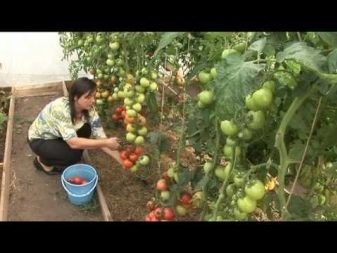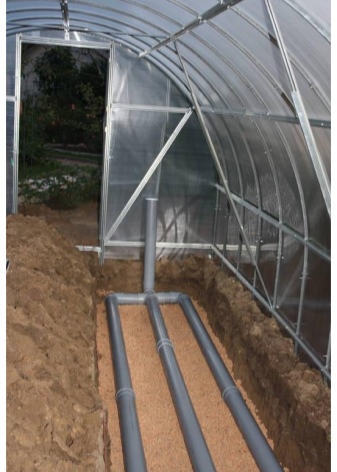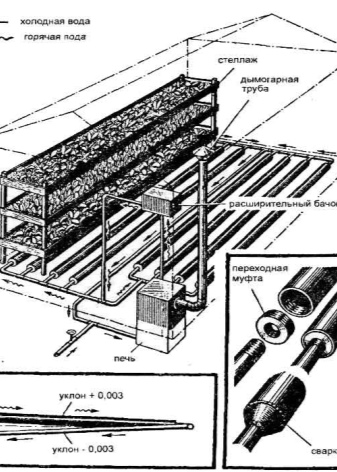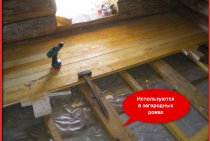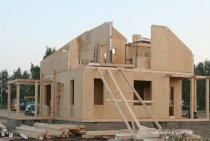Greenhouse soil cable heating system
With cable electric heating, local heating occurs near the roots, that is, that part of the soil in which the roots of a heat-loving plant are located is heated. For this, 2 types of heating cable are used: resistive or self-regulating. The most important difference is that the self-regulating heating cable is not afraid of overheating. It can be stacked on top of each other without fear that the place where the cables meet will burn out. The resistive wire has a constant power, and if the cable locks and overheats during operation, it will fail.
Greenhouse heating with resistive cable
For the purpose of heating the soil in greenhouses, resistive cables for anti-icing systems with a linear power of 10-15 watts per 1 linear meter are often used. Commonly used options include:
- Armored sections 10 TSOE2 - armored single-core heating sections from the manufacturer LLC SST, Mytishchi, RF. Available cable lengths: from 58 to 218 meters. The main advantage is twisted armor, which protects against damage by a shovel or other objects during tillage. The disadvantage is the high price and complexity of installing a heavy and elastic cable;
- Single-core heating cable NSCT with a linear power of 10-15 watts from the same Russian manufacturer SST LLC. The cable is relatively cheaper than analogues, because. is single-core. This complicates its installation, because. both ends of the cable must be connected to a single source of electricity after laying out;
- Single-core sections ICE FREE O and two-core sections ICE FREE M from another Russian manufacturer PK TS Polyus LLC. These variants of heating sections are not inferior to analogues in terms of characteristics, but at the same time they are 10-20% cheaper.
The use of resistive heating cables would be the best solution as manufacturers offer a wide table of section sizes and capacities suitable for the most complex and non-standard solutions. In addition, cables can be selected for more or less aggressive operating conditions in order to increase the efficiency of the greenhouse heating system.
Ready kits (Green Box AGRO)
The Russian manufacturer CCC LLC was one of the first to produce ready-made solutions for ground heating - Green Box Agro kits on two-core shielded heating sections 14GBA. The linear power of the sections is 14 watts per m / rm. In addition to the sections, the kit includes a box and a thermostat TR 600 to control the soil heating system.
The cable sheath is made of special polymers that are resistant to aggressive environments (high humidity, fertilizers). The cable is equipped with a foil shield that meets all safety requirements against electric shock. The model range includes 9 standard sizes (from 200 to 1480 watts) with a heating area from 2 to 15 m2.
It must be said that the GBA sets are one of the most optimal solutions for heating the soil of greenhouses, since the linear power of 14 watts is just enough to warm the seedlings and seedlings and at the same time not dry the soil and burn the roots. The manufacturer has been developing this system for a long time together with specialized research institutes and has developed the most efficient system.
At the moment, similar products are produced by other Russian manufacturers: Teplyshko (Kaleo), SNGT from Chuvashteplokabel, Heatline-Grunt from the manufacturer Heatline. They are slightly cheaper, but inferior in quality to Green Box Agro.
Greenhouse ground heating with self-regulating cable
One of the advanced solutions in greenhouse soil heating is the use of self-regulating heating cables. The cable is based on a self-regulating nano-matrix, which independently increases heat dissipation if the ambient temperature is low and, conversely, reduces its power if it is warm around.
This cable is ideal for greenhouses for the following reasons:
- Self-regulation. In the event that an air cushion has formed in the ground or the area with the cable is covered with something, then it will simply throw off the power. At the same time, an ordinary resistive cable may burn out;
- Saving electricity.This cable allows you to point to reduce or increase the temperature where necessary. Due to this, electricity can be saved up to 70%;
- Sections of any length. The self-adjusting cable can be cut to any individual length. The resistive cable comes in strict segments, which are often not enough or, conversely, it turns out to be too much for your greenhouse.
Soil heating
The reason why we chose electricity rather than water heating of the greenhouse is that the first option is technically easier to do with your own hands. Soldering water pipes is quite difficult, you will also have to think about whether to power them from a house boiler or installed in the greenhouse itself.
The first option - without mounting a concrete base
Preparing the beds for organizing warm soil in the greenhouse is very simple: we remove the soil to a depth of 40 cm, put it in bags, and take it out of the greenhouse. Installation without pouring concrete will be carried out as follows:
- We pour out a sand cushion 10 cm thick. In this case, we lay the cuttings of boards on the sand, a meter apart.
- We lay out the self-regulating heating cable for heating the soil of greenhouses from above, fixing it with special fasteners to the tree.
- We cover everything with polyethylene, the edges of which should be slightly on the walls of the beds.
So, we did the heating of the soil in the greenhouse with our own hands. Now you can fill the soil, begin to prepare it for planting.
Please note: for the convenience of heating regulation, it is better to place a thermoregulation device with switches near the front door. Accordingly, we lay the cable in the ground with the expectation of this. . We make a warm floor in a greenhouse with our own hands: installation without a cement screed
We make a warm floor in a greenhouse with our own hands: installation without a cement screed
Organization of soil heating with a cable under the screed
First, as in the first case, we remove 40 cm of soil, then we make a sand cushion (10 cm). Along the edges of the floor of the heated greenhouse, we organize a board 15 cm high, which will prevent the cement from spreading beyond its limits. We compact the sand well, achieving the most even surface. Next, we work like this:
- We lay a layer of waterproofing material, for example, a dense cellophane film.
- On the film along the length of the greenhouse we place several metal profiles or wooden beams (30x40). The step between the elements is 60-80 cm.
- We knit a reinforcing mesh from a steel bar, spread it on a prepared surface. We fasten the mesh to the profiles / timber with a knitting wire.
- On top of the grid we lay out the soil heating system in the greenhouse. Wires to it are attracted by plastic clamps.
Installation of a heating cable in a greenhouse under a concrete screed
For your information: we make a heating screed using a concrete-sand-gravel mixture. The consistency should be the same as in the photo below. The pre-hardening of the screed will occur after about 3 days. If it is not planned to build any structures on its surface, after this time, you can proceed to pour the soil.
We equip a greenhouse with heated earth with our own hands: pouring the screed
Another option for underfloor heating in a greenhouse, the video shows the installation of a carbon cord. The principle of soil heating is the same as when laying an electric cable for heating.
Warm bed in a polycarbonate greenhouse biological method
The biological method of heating the beds is carried out using natural biofuels laid in the subsoil. As a filler, plant remains, sawdust and manure are used, which are spilled with water for the rotting process. Such beds are the most economical design.
Warm beds running on natural fuels are usually divided according to the type of construction:
- Buried, when fertile land is removed, a trench is pulled out, compost is laid and filled from above with soil so that it is at the level of the total mass of the earth;
- Raised beds, the top layer of earth is removed from the surface and placed in special wooden boxes, which serve as protection against shedding and washing out of the earth during operation;
- A hilly bed, laid without a box on top of the main platform;
- A combined option, when the lower layers with organic matter are laid at ground level, and the fertile soil layer is fixed with a box.
To make the construction of a combined warm ridge, it is necessary to mark out places for future plantings. Then carefully remove the layer of sod, setting the fertile soil aside. Next, you need to dig a trench up to 60 cm deep. To protect against freezing, foam plastic or closed plastic containers are placed at the bottom of the trench. Then the first layer of organics begins, consisting of large branches, wooden chocks, large plant objects.
This layer will play a drainage role. Then lay the paper substrate, consisting of waste paper.
After that comes a layer of smaller organics, food waste, tree leaves, small grass stalks. Next, pour ready-made compost, or semi-rotted manure, to start the process of decay. We install a pre-prepared box in which we will pour fertile soil. Each laid layer must be well shed with water. We cover the last layer with fertile soil. The soil enriched with organic matter is perfect for planting tomatoes, pumpkins and cucumbers. The process of decay is able to heat the earth for 2 months.
Advantages and disadvantages of heating the soil with a cable
Previously, summer residents had to use "potbelly stoves" as additional heating. Thanks to the rapid development of modern technologies, farmers have abandoned this archaic method, preferring new devices.
Since the temperature of the soil, not the air, is more important for plants, special cables began to be used to heat it.
Such a system allows you to turn on the heating as needed, regulate and maintain the desired temperature.
Heating can be carried out locally or spread throughout the greenhouse. Thanks to the possibility of local heating, farmers can grow several crops in one greenhouse at once, which differ in temperature requirements.
Soil heating is accompanied by several advantages at once:
soil freezing prevention;
reliable protection of plants from frost;
acceleration of plant growth, fruit ripening;
increase in the fruiting period;
accelerated seed germination;
growing heat-loving varieties of vegetables (this is especially important for regions with a cold climate).

The benefits of such a system are reflected not only in the growth and development of plants. Farmers welcome the proposed method also for its following properties:
- safety (when using water, in the presence of branches and other foreign objects in the ground, accidental overlap of cables, the system will not fail, will not create conditions that are dangerous to humans);
- economy (low power consumption);
- convenience and the possibility of specific installation (in one greenhouse you can lay cables of various sections and capacities).
Do-it-yourself simple greenhouse with heated ground
Water heated beds also have a number of advantages. Firstly, the condensate that forms on the pipes additionally moistens the soil. This design provides uniform heating of the air in the room. To heat the greenhouse, you will need a gas or electric boiler, you can also use a small stove made of brick or metal on wood.
To it you need to purchase a pipe for the exit of smoke. The choice is made in accordance with the configuration of the heater.
To install a furnace or boiler, it is necessary to prepare a foundation, for a brick structure - concrete. A metal boiler can be placed on a sheet of a mixture of asbestos and cement.Further, the structures provide stability and attach the chimney, hermetically sealing the connection points.
Insulation of beds with pipes, necessary work:
- Remove the soil with a thickness of 35-40 mm;
- Material for thermal insulation is laid out at the bottom of the resulting trench, usually foam is used;
- Water pipes are placed on top and connected to the heating system;
- Fertile soil is laid on top of the pipes.
This method of heating is considered optimal, however, it is necessary to ensure that the temperature of the water in the pipes does not exceed 45 ° C, otherwise the roots of plants can be burned.
Advantages of ground heating with a heating cable
Such a system is ideal for the Belarusian climatic conditions, it will not only protect the soil from severe frosts, but also preserve its fertility and quality. The depleted soil is not able to give the desired harvest, if we take care of it, then it will take care of us. Frost does not allow the soil to be saturated with either moisture, or heat, or useful minerals, and the heating system will provide the soil with the opportunity to feed and bear fruit at any time of the year.
Thus, we can distinguish the following advantages of purchasing a plant soil heating cable system:
- Early sowing. Thanks to warm soil, seedlings can be planted in a greenhouse about 1-1.5 months earlier than usual and harvested until late autumn. Thus, you can get 2 crops in 1 year;
- Comfortable and safe growing conditions. Saplings and seedlings will not freeze in case of frost and will grow and bear fruit more intensively;
- Relatively inexpensive parts. The price of the entire system, depending on the size of the greenhouse, will cost $ 100-300;
- Economical consumption of electricity. We are not required to heat the entire greenhouse. The cable warms up the soil and plant roots. For this, 1 sq. a meter of beds is laid with a power of about 80 watts / m2. The use of thermostats reduces energy consumption by another 30-70%;
- Quick installation. Unlike boiler water heating, the system can be installed in 1-2 days. If you use water boiler heating, then it will take more time and money to install it.
Soil electric heating systems equipped with temperature controllers monitor the temperature in the greenhouse and will become indispensable helpers for every landowner. Previously, much more effort and time was spent on providing plants with a comfortable existence even in cold seasons. Soil heating systems make it easy to manage your yard and vegetation. Heat, moisture and mineral decomposition are the main elements that provide the earth with vitality, such an issue is now resolved much faster thanks to these systems.
Generally speaking, this whole system is a kind of heating for the soil and plants during the cold season. Why not let nature exist even in frosts, taking into account the needs of each of the plants and the ability to provide full-fledged comfortable conditions? If modern technologies can provide heat to the soil and plants in a cold winter, then it remains only to choose the best option!
Installation
Installation of a cable electric soil heating system in greenhouses consists of the following steps:
Under the greenhouse, it is necessary to remove a layer of earth about 40 cm deep;
We wake up the bottom of the pit with a 5-centimeter layer of sand. Sand must be shed and rammed for the strength of the foundation;
We place a reinforced mesh with cells of about 10 cm on the sand and lay out a heating cable on it. Fasten the cable to the grid with plastic ties so as not to damage the outer sheath. The wire is laid out in a snake with a laying step of approximately 12-15 cm;
Between the turns of the heating cable we install a temperature sensor, which is desirable to be placed in a corrugated tube;
Sprinkle the mesh with the cable with a layer of sand by 5-7 cm and again spill and tamp it down;
On top we put a fine-mesh reinforced mesh to protect the cable from mechanical damage with a shovel or other objects;
From above we fill the system with a fertile layer of soil;
Install the thermostat and connect the cable to it
Attention! It is advisable to install an RCD in front of the thermostat to ensure safety against electric shock.
After completing all the installation steps, you can safely plant seedlings and connect the plant root heating system in your new greenhouse.
We make warm beds in the greenhouse types of heating
Solar heat warms the beds only by the beginning of May, in some regions and by its end. Artificially heated soil is suitable for planting in March, while the root processes are in comfortable conditions, which contributes to their strengthening and plant growth. In addition, the heat released by the earth helps to warm the air in the greenhouse.
Advantages of warm beds:
- Early planting and achieving maximum yield in the first summer months;
- Getting a good result even on relatively fertile soil;
- Reducing the need for plant nutrition;
- Increase in the fruiting period;
- Reducing water consumption during irrigation;
- Weed control.
The preparation of a warm bed in a greenhouse is carried out in autumn or early spring. There are several options for heating the beds: electric cable, water pipes, biological compost. When using a cable, it is laid in advance under the soil and heated using electricity. These designs are highly efficient, but expensive to maintain.
Water heating is used with the use of special pipes made of polymer material, which are laid under the ground.
Hot water flows through the pipes, which can heat the earth. For biological beds, plant remains and manure from livestock activities are used. The heating element is the process of decay, as a result of which the temperature of the soil rises. This is the most economical way to heat beds. Each method has its pros and cons. The gardener selects the most acceptable option, based on his own views on growing plants.
What are the benefits
The main arguments why it is not advisable to use soil heating systems in a greenhouse are a weak effect on small areas and the high cost of equipment. Many believe that the greatest benefit from soil heating in protected ground conditions will be in farm greenhouses, in which vegetables are grown throughout the year. However, warming up the soil in ordinary, seasonal structures is beneficial for the following reasons:
- Heat loss through the soil is excluded;
- Planting seedlings can be done at any time of the year in order to get a crop by the time the price for it increases to the maximum;
- In warm soil, the root system of the culture develops well, which is why the aerial part is formed and grows even better;
- The yield is increased, expressed in kilograms of fruits harvested per unit area;
- The period of fruiting increases;
- The constant temperature of the soil in the greenhouse eliminates the death of plants during frosts.
Greenhouse Kits

The soil temperature is controlled by a TR-600 temperature controller. The temperature controller includes an external temperature sensor, with which the soil temperature can be maintained in the range from +18 to +27 with an accuracy of 1 °C.The product is designed to operate in high humidity conditions. The maximum current is 16 A at a supply voltage of 220 volts. Thus, several heating sections can be connected to the product within this current value. The cost of a thermostat is about 3 thousand rubles, heating sections - from 2 to 6 thousand rubles.
A similar system is offered by the South Korean company Lavita. Products are completed with sections based on a thermal cable with a linear power of 20 W per meter. The range is from 200 to 2800 W with a section length from 10 to 140 m. The cost of the section is from 1.5 to 15 thousand rubles. In addition, this company offers two types of thermostats: conventional and programmable, which allows you to program the regulator for a week. The price of regulators is 1100 and 2300 rubles. respectively.
All regulators are supplied separately and can also be used to build a heating system based on self-regulating thermal cables.
The following materials:
- 04/12/2016 15:27 — Construction and construction In order to properly build a greenhouse or greenhouse, you must first decide on their main practical pre…”> Greenhouses and greenhouses: the secrets of construction and maintenance, planting and caring for various crops
- 27/07/2016 00:00 — On the influence of the color of the shading net on plants in the greenhouse As soon as shading nets appeared in greenhouses, the desire immediately arose ...
- 02/27/2016 22:18 — The mention of non-woven materials immediately evokes an association with spunbond. This is already a household name not only for a whole class of materials, but also for t ... "> Non-woven materials in agriculture: varieties, properties, applications
- 08/02/2016 22:53 — Agree, high-quality, multi-year greenhouse film is the absence of costs and worries for several years. However, non-observance of simple rules can force ... "> For the greenhouse film to serve for a long time
- 24/01/2016 23:14 — Covering film materials for greenhouses In recent years, there has been a noticeable passion for greenhouse forms of management, both in amateur and…»>Modern films for greenhouses
Previous materials:
- 01/05/2016 22:30 - Unlike stoves, pyrolysis hot water boilers are more convenient because they allow you to organize not only a uniform distribution of heat throughout the greenhouse, but also throughout ... "> Pyrolysis hot water boilers for greenhouses and outbuildings
- 28/11/2015 08:20 — There are quite a few ways to heat greenhouses. From the simplest, for example, put 1–2 buckets of boiling water in a greenhouse so that the seedlings are not grabbed at night for ... "> Heating of greenhouses and greenhouses: traditional and modern methods
- 09/30/2015 22:44 — Flexible translucent polycarbonate panels are great for building a greenhouse. This polymer material is very fond of the consumer for the highly ... "> Which polycarbonate to choose for the greenhouse
- 19/05/2015 11:35 - Economic sanctions against our country, followed from abroad by former partners, served as an impetus for price gouging for many industrial and other ... "> Private greenhouse farming on a real example
- 30/04/2015 12:58 - Greenhouses: what, why and why
Next page >>
How can you heat a greenhouse in the country
When choosing how to heat a greenhouse in the country, vegetable growers consider the following sources of thermal energy:
- solar radiation based on the “greenhouse effect” (the greenhouse or greenhouse effect is the increase in air and soil temperature in cultivation facilities due to the conversion of short-wave solar energy entering through glass or film into thermal (infrared) energy that does not pass back through the translucent fence);
- biochemical reactions during the decomposition of organic materials by microorganisms (biological heating);
- heating of water and air during fuel combustion (water, calorific heating, direct combustion of gas in greenhouses);
- geothermal waters (water and calorific heating);
- electrical energy (electric heating).
The most economical sources of heat for heating a greenhouse are waste heat from industrial enterprises and geothermal water.
The economic efficiency of heating systems is determined not only by the cost of thermal energy sources, but also by their location, period of use and other factors. With a decrease in the temperature of the coolant and its removal from the greenhouses, the economic efficiency of heating greenhouses decreases.
In winter greenhouses, where 30-50% of all operating costs for growing vegetables are for heating, the economic efficiency of heating systems is mainly determined by the cost of the heat carrier. In spring film greenhouses, the costs of maintaining the optimal temperature regime are much less, and their main component is the cost of depreciation, maintenance, and current repairs of heating systems. Under these conditions, the electric method of heating greenhouses is no less effective than other methods.
Opinion of the owners
If you look at the reviews of the owners of warm beds, you can see a really rosy picture. A larger number of authors argue that growing seedlings in warm beds, and even in greenhouses, only has the best effect on the crop. Those who use organic warm beds claim that in any climatic conditions, the yield increases several times. They note the ease of formation of such beds, the possibility of early planting seedlings and, accordingly, earlier harvesting. Also, many point to the economy and durability of this method. On any site there will always be ingredients for creating this type of beds. And even a woman is capable of building it with her own hands.
The owners of electric warm beds point to the ease of installation, if the instructions are followed exactly, and the durability of such a structure. Of the minuses, only the fact that such a system can not be found in stores can be distinguished. Some users order installation kits online. They note an increased yield, early ripening of fruits and full automation of this method, if a thermostat is installed.
Many gardeners prefer the water method of heating the beds. Of the advantages, in addition to high yields and early ripening, they distinguish the possibility of self-assembly of this type of heating. Any man is able to install pipes of the required size and diameter, connect a water pump and install a stove to heat water. In addition, this method, as the authors note, is more economical than electrically heated beds.
